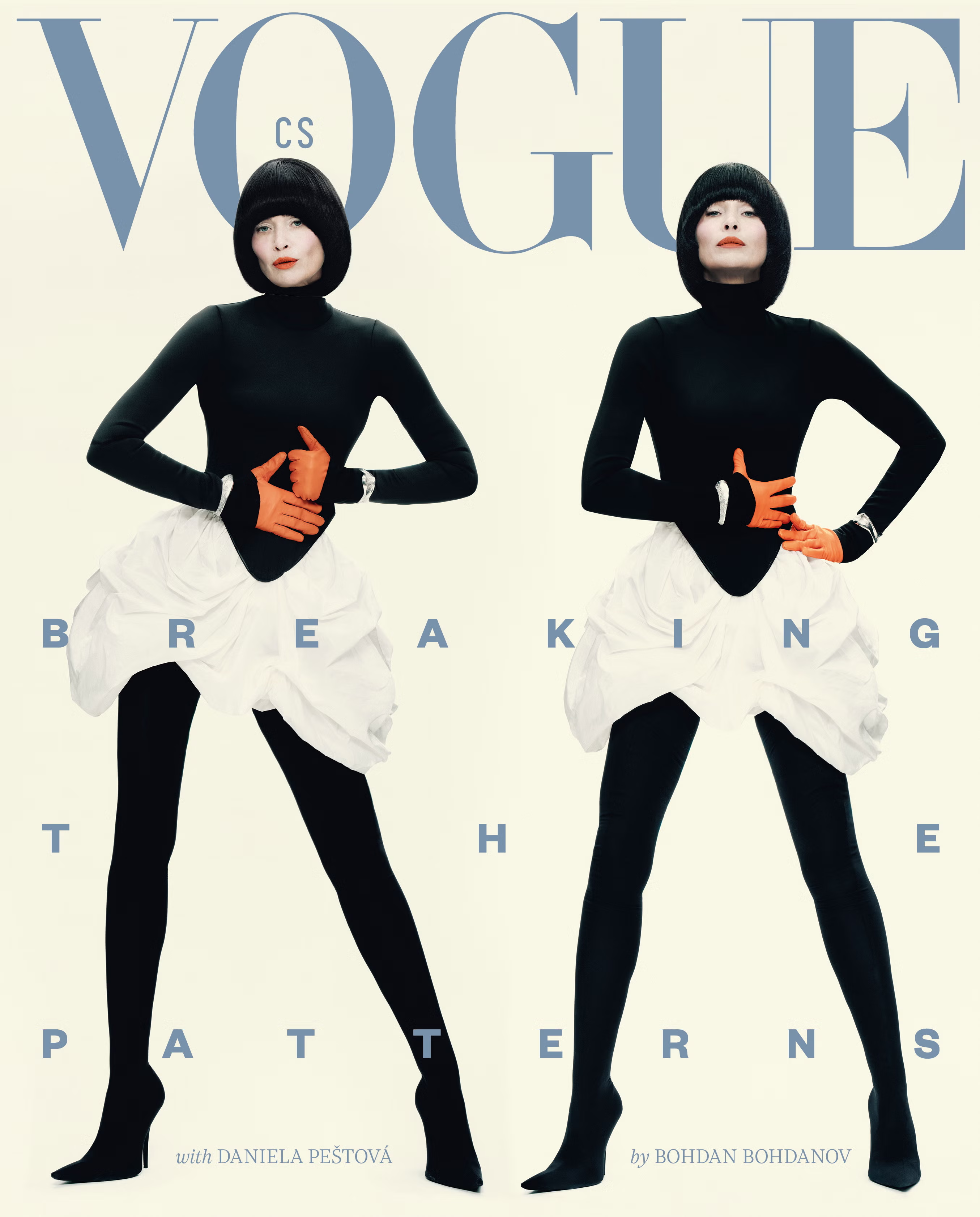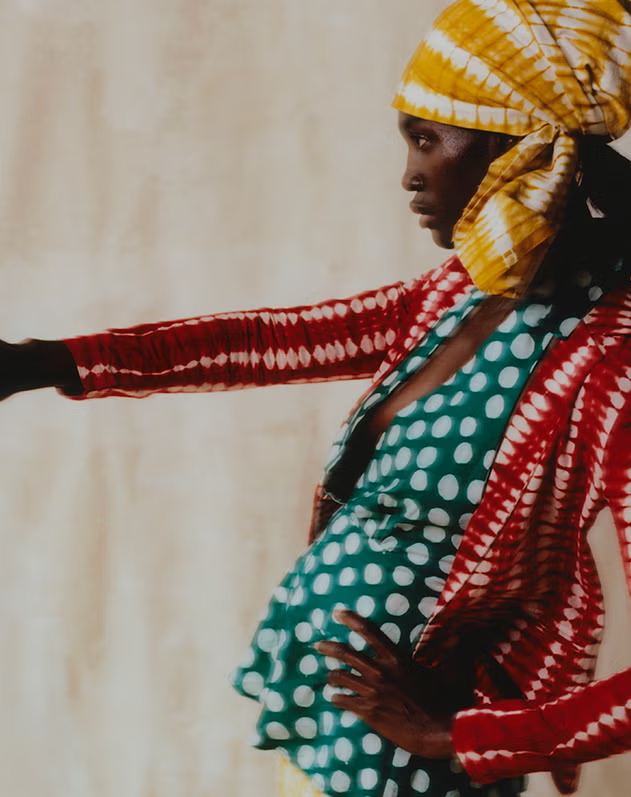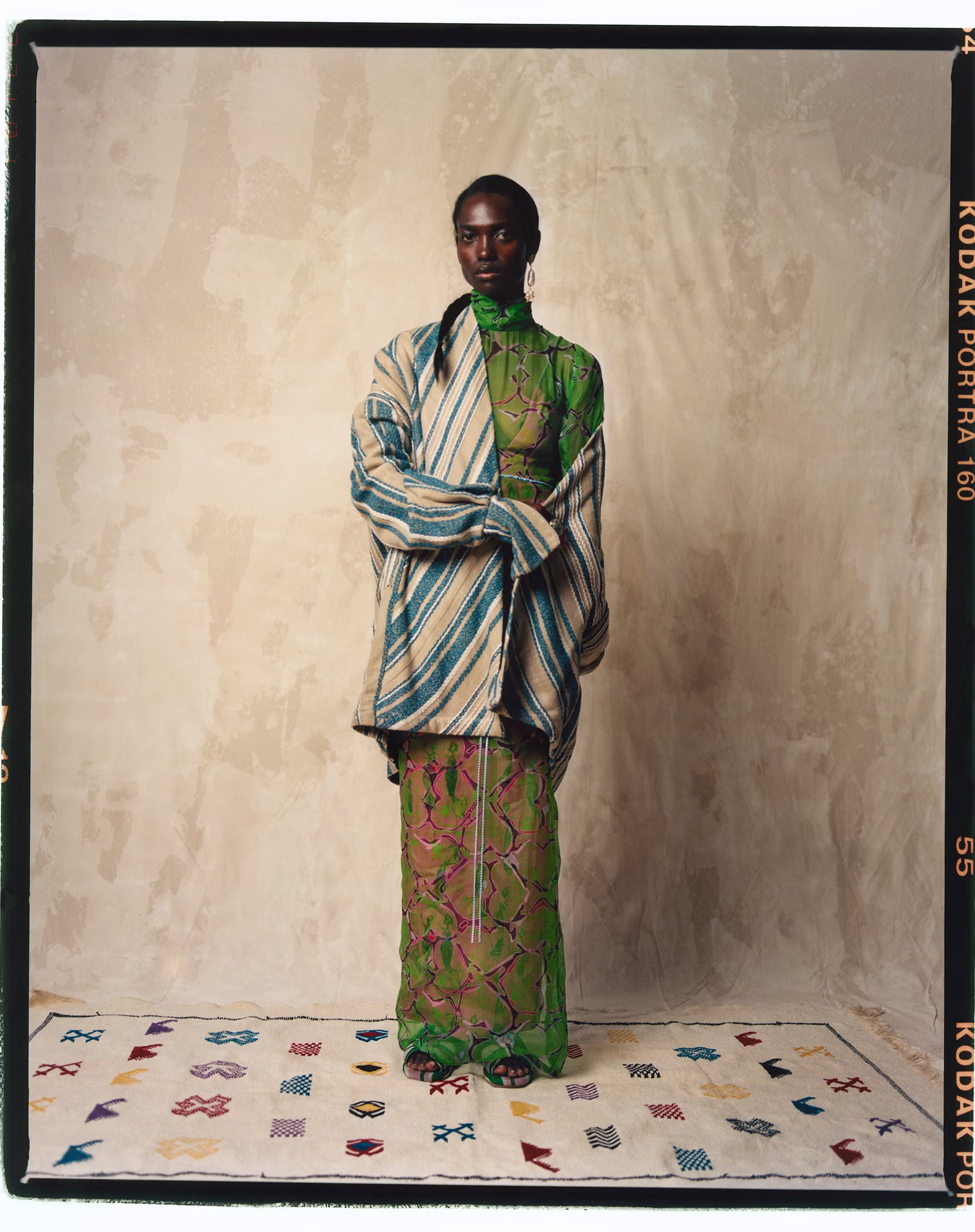Vogue CS in English
Interview with Anyango Mpinga of Anyango Mpinga
Ooooota Adepo1. 8. 2020

Anyango Mpinga
Ooooota: When did you realise you wanted to be a fashion designer?
Anyango: I was about 26, watching a runway show for a fashion event I had helped organise when I realised that a career in fashion was something I wanted to pursue. Up until then, I ‘dabbled’ with fashion as a hobby. I would convert outfits from thrift shops into pieces that reflected my individual style and aesthetic. I would also collect materials with African motifs and design outfits for myself, using a local tailor to bring my vision to life. I was a lot more adventurous with sewing when I was younger because I had this fascination with making clothes for my dolls. I learnt how to knit sweaters and was pretty handy with hand stitching, something I continued with as I got older when I needed to mend my own clothes. I wasn’t even thinking about being a designer and fashion design as a career was something I could only relate to through television and magazines. But the more I designed clothes, the more passionate I became about learning about the industry. I knew that if I were to take my passion for fashion seriously, I would want to incorporate sustainability into my supply chain. It took me a few years to figure it out as I experimented a lot, and by the time I launched my eponymous brand in 2015, I felt more confident about the direction I was taking with my brand.
Ooooota: How has your Luo and Sukuma heritage inspired your work?
Anyango: These two cultures are so different and also very similar. I was brought up in Kenya and I am more familiar with Luo culture. I have referenced cultural elements such as the Kondo Udo, a regal traditional feather hat worn by warriors and dancers from my Dholuo tribe which undulates in the wind with every movement. The Luo people are lakeside Nilotes. We take pride in our culture, food and music and are a vibrant community found around Lake Victoria. I have referenced the Kondo Udo twice when designing textile prints for my collections. The Sukuma are a Bantu ethnic group from the south-eastern African Great Lakes region inhabiting the area of Tanzania south of Lake Victoria between Mwanza Gulf and Serengeti Plain. The Sukuma have a holistic view of the world and see it as being interconnected with all living things, natural and supernatural. There is a lot of spiritual symbolism around traditional crafts from the Sukuma tribe. The most symbolic are the carvings, associated with large, rough-looking standing figures. The figures carved with articulated limbs, known as Amaleba, are used by dancers during ceremonies in the dry season. The idea of dance and movement in particular when reflecting on my multicultural heritage is something that inspires my work. While drawing inspiration from cultural elements, I am also conscious of the symbolism of the spiritual element of my background, which would require a deeper understanding of these symbolic figures before attempting to translate or depict them in contemporary fashion.
Ooooota: You also draw inspiration from contemporary art. Are there any artists specifically whose work influences your design process?
Anyango: Whenever I come across an artist, especially from the African continent, I try to find ways to collaborate with them especially when we have shared interests. My most recent collaboration is with Kenyan award-winning artist Onyis Martin, whose work explores how the narrative of slavery remains as constant and present phenomenon, and reflects in human trafficking, a form or modern-day slavery. His paintings feature on my Human Oneness campaign for the Free As A Human initiative. Some contemporary artists whose work I love include Wangechi Mutu from Kenya, Nelson Makamo from South Africa, Yinka Shonibare who is British-Nigerian, Ethiopian photographer Aidah Muluneh and Lina Iris Viktor, a Liberian-British conceptual artist and painter.
Ooooota: You are described as an eco-innovator who embraces circular fashion. Why have you chosen to create in this way?
Anyango: By using raw materials that would otherwise be considered waste in the design process, I make sure that my clothes are made well and consciously. I started researching plant-based materials which I’m exploring in textiles. Circular fashion is intertwined with eco innovation because you’re designing with waste elimination in mind. It’s about reusing resources, recycling and also making sure you create products that have a long lifecycle. When they are no longer in their most valuable form, they can be returned safely to the biosphere.
Ooooota: How do you define conscious consumption?
Anyango: Conscious consumption is about making the right choices about what you spend your money on. You can either choose to buy an item that is very cheap, will not last long; has been made by workers who are modern slaves and made from materials that are toxic for the environment. Or, you can choose to spend a little bit more money on something that has been made well, made to last and is better for the environment. Why is it important for Africans to embrace this? For many years Africa has been a dumping ground for second-hand clothing from the rest of the world. Even when we buy new clothes in shops, there isn’t enough education on materials and making good choices, perhaps because economically a large percentage of people do not have the luxury of choice and there aren’t enough clothing options to cover different income levels. Fashion designers have a big role in educating consumers to make better choices. While encouraging African consumers to shop more consciously, we also have to provide them with options to replace the products they are used to consuming, in order for us to see a real shift. It’s not going to happen overnight, but educating the consumer is a start.
Ooooota: Your Phonology collection features the sound of love print made of sound waves of the words ‘I love you’ in 25 global languages, 10 of which are from Kenyan tribes. I think this is a fascinating way of merging technology, tradition, and the universal concept of love. Where did the inspiration of this come from? Do you intend for people to feel more connected through wearing your designs?
Anyango: The inspiration for the sound of love print came when I was talking to a friend about universal love. We started talking about soundwaves. At the time I was thinking, if I wanted to wear love, what would I want it to look like? Did I want to have the words written all over or did I want to use heart motifs, which everyone uses? The next day I made a list of countries I had been to around the world and did research on how each country says I love you in their native language. I recorded myself saying I love you in each language and took screenshots of the sound waves. That’s how the print came to life. I also listed 10 main Kenyan tribal languages and used the same process. There are 42 tribes in Kenya with a long history of tribal clashes. I thought about what it would be like to create a national print that everyone could relate to no matter where they are from because love is the one language everyone understands. My desire each time I create a print is for people to understand the message behind the print, feel connected to the message and also realise that it doesn’t matter where they come from. The message is still connected to who they are.
Ooooota: You are passionate about human rights and women’s rights. Does this come from your experiences and what you’ve seen as an African or is this a bigger response to a human obligation?
Anyango: I was brought up in a Baha’i family. One of the earliest Baha’i quotes is this one, “The world of humanity has two wings, one is women and the other is men. Not until both wings are developed can the bird fly. Should one wing remain weak, flight is impossible.” Equality between men and women is at the centre of understanding the importance of human rights. I was brought up to learn about the rights of all people no matter their background, so this was normal to me. It was only when I got older that I started understanding the inequalities that exist in our society and the world, so I was always faced with the question of how I could address these issues through my art. I took a human rights class at university and wrote a paper on human trafficking. What we see in Africa is the normalisation of inequalities as part of our culture. In most languages in Africa, there isn’t a word for forced marriage or rape for instance. It poses a challenge when you’re trying to engage communities in conversation to tackle these issues of injustice when there is no word in their native languages that describes the subject you’re trying to talk about. When it comes to trafficking, it is not uncommon for young girls to be married off to pay a family debt. It is only in recent years that communities have been informed that this is a form of human trafficking. We see street children everywhere and domestic workers who are hardly paid for their work. As an artist I feel a deeper sense of responsibility to find ways to communicate these important messages in my own way, with an emphasis on solutions and the fact that we all need to work together to see change. I believe that if we all started seeing just how connected we are no matter where we are in the world, we would respond to matters concerning human rights actively rather than passively.
Ooooota: How do you see the African fashion ecosystem evolving?
Anyango: I feel as though in the past few years we have seen increased appreciation of our unique cultures and traditions. Our rich continent has been inspiring global fashion houses for decades. However, it's taken numerous incidences of cultural appropriation from global non-African brands for us to have our wakeup call and start appreciating and celebrating our culture and art. We now have some of the most innovative brands in the world coming from Africa and we have only just scratched the surface of the talent the continent is birthing. It’s important to note that we can collectively contribute to the growth of the continent if we allow free trade across countries and improve infrastructure and transport links for us to be able to better trade with each other, and for Africans to have better access to what other Africans are creating across the continent. This will boost the fashion industry tremendously. There is no reason why it should be more expensive for me to ship my products between two countries on the African continent than it is to ship to Europe or the US. We should be able to incentivise manufacturing on the continent to make it easier for Africans to produce in Africa and invest in textile production to grow the industry. We need to see more retail spaces opening up for fashion designers, and governments should have a general rule on all international chain stores opening stores in African countries to stock at least 10% of products in their stores from African designers. Small steps like these are bound to improve a designer's access to market. We have a lot of work to do and we can learn a lot from countries that are thriving in manufacturing and the textile industry.
Ooooota: How can African fashion tell the story and preserve the histories of Africans with integrity?
Anyango: We need to understand more about the cultures we represent through our designs and understand the symbolism behind each cultural practice. For instance, when you bring to mind the Kente cloth, the traditional cloth of Ghana worn by several Ghanaian tribes, the cloth has symbolic meaning. It is an Akan royal and sacred cloth worn only in times of extreme importance and was the cloth of kings. It's so important to understand the history of garments and to honour these traditions even as we use historical art and textiles in modern fashion. The difference between cultural appropriation and cultural appreciation lies in the storytelling, giving credit to the cultures you have drawn inspiration from and respecting these cultures. it is very important to preserve our history and integrity and pass on information to future generations. Our history was re-written through colonialism and there is a lot of information, traditional artefacts and information which has been lost through time, so it is important to preserve what we know and take pride in our unique identity.
Ooooota: On the subject of African traditions, motifs, and ways of expression, is it more important to educate the world about Africans or Africans about Africans?
Anyango: I think as Africans, it is important for us to understand each other, we are after all a vast continent with unique traditions specific to our regions. Even when we look into individual countries, it's so important to learn about each other and understand why we believe in the values we hold dear. Otherwise we will always see each other as strangers rather than as equal members of a rich continent that has a lot to offer the world.
Ooooota: What is next for you?
Anyango: I am currently exploring the use of emerging technologies in textile innovation, utilising plant-based raw materials as a sustainable alternative. I recently created my first 3D collection through technology that explores garment construction without wasting material during prototyping. I collaborated with a Ghanaian agency called Balm Labs, where I worked closely with the agency’s female founder, Baboa Tachie-Menson to create looks on plus size female avatars. I will continue to explore the world of virtual reality in presenting my work. My non-profit initiative, Free As A Human supports female survivors of trafficking in Kenya. I’m creating an apprenticeship program that will see women matched with professional opportunities, which will introduce new skills to them from which they can earn a decent living.



